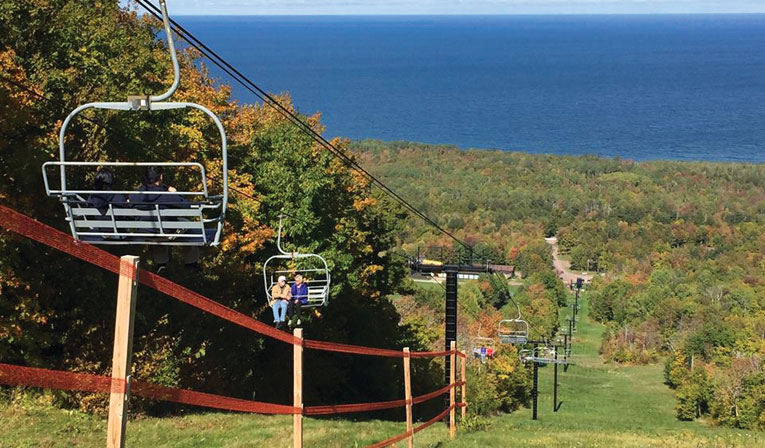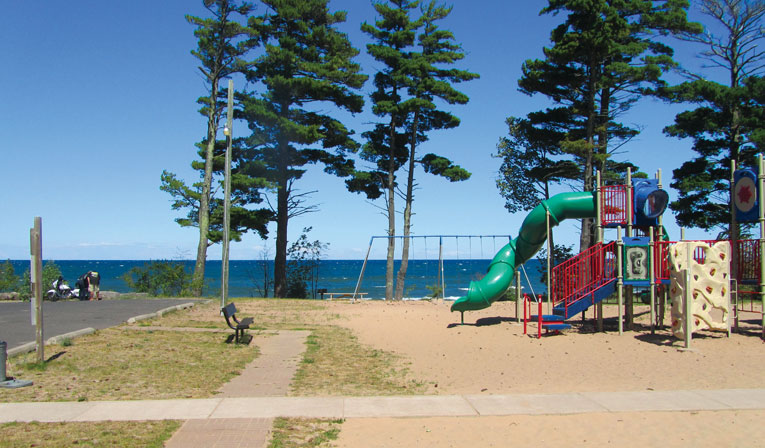Photo by Nathan Invincible
Nestled alongside Lake Superior and the Porcupine Mountains, Ontonagon, Michigan offers stunning landscapes, a deep mining heritage, restaurants, museums, shops and more.
My family and I cruised north along the wild Lake Superior shoreline of Michigan’s Upper Peninsula (U.P.), where marinas are 30-some miles apart. We had just traveled 35 miles from Black River Harbor, and it was another 38 to the upper entry of the Keweenaw Waterway. My husband, Mark, said the wind was picking up and we should probably head into Ontonagon for the night.
We had visited Ontonagon County by land a few years earlier for the annual Porcupine Mountains Music Festival held every August. It was a terrific weekend of live, eclectic music with the backdrop of beautiful mountains; we were excited to return and explore the area. A day or two in Ontonagon to wait for the wind to calm down sounded delightful.
The Keweenaw Peninsula and its rich resources — copper, fish and forests — have attracted people for 7,000 years. Ontonagon is the oldest permanent settlement on Lake Superior’s south shore. The village was founded in 1843 at the mouth of the Ontonagon River and served as a shipping port for the booming U.P. copper mining, fishing and lumber industries.
The first people hammered and chiseled to get to the pure copper; later, sophisticated mines, drilling and dynamite expelled the copper. Miners in the 1800s and early 1900s worked 10-hour shifts, six days a week. In 1920, the underground mines were left vacant and the remaining copper was abandoned. At that same time, the lumber companies were clearing U.P. white pine, which was expected to last a thousand years. But 50 years later, the trees were gone and the land was left to the townships. Immigrants who came to the area for the mining bought the land for back taxes and started businesses and farms.
Today, Ontonagon County is home to the descendants of the native people and immigrants who came for the natural resources and opportunities. It’s home to people who appreciate the incredible natural beauty. And it’s nestled amongst two natural giants: Lake Superior and the Porcupine Mountains.
The Porkies
Perhaps the biggest draw to the Ontonagon area is the Porcupine Mountains Wilderness State Park, which brings more than 300,000 visitors every year. About 15 miles west of Ontonagon, it’s Michigan’s largest state park and has the tallest mountains in the Midwest, majestic and wild — especially when seen from the Big Lake. The 60,000-acre park has 90 miles of backcountry hiking trails, waterfalls, rivers, and a virgin forest of eastern hemlock and northern hardwoods.
According to Bob Wild, the park’s naturalist: “The primary reason we are a park is because a group of organized citizens pushed to protect the old-growth forest found in the present-day park. They saw value in preserving a small portion of the state so future generations could see what our landscape has looked like [unaltered] for hundreds of years. Because of this effort, we have the largest old-growth northern hardwoods forest in the Midwest — if not the entire country.”
Wild recommends three scenic sites to visitors: Lake of the Clouds, Summit Peak and Presque Isle River. “All of the sites are very scenic and each could easily be a park all by itself,” he says.
Lake of the Clouds, a stunning mountain lake, has a lookout easily reached by car. You can also hike trails to the lake. The Presque Isle River features three gorgeous waterfalls: Manabezho, Manido and Nawadaha Falls. The Summit Peak observation tower is one of the most visited spots in the “Porkies” for its incredible view.
In mid-September, the fall color chairlift rides begin in the park, giving visitors an exceptional picture of the autumnal colors of the Upper Peninsula — from above. The park hosts other events throughout the fall to celebrate this beautiful season.
Park visitors will find interpretive programs all season long. They can also take a class through the Porcupine Mountains Folk School. Renowned artists teach topics ranging from stained glass arranging and watercolor painting, to hand-forging copper bracelets and creating a Greenland-style kayak paddle. Many of the classes reflect the Scandinavian heritage of the area’s immigrants, like making a Viking weave wire-woven bracelet.

Photo Courtesy Porkie’s Facebook
Porcupine Mountains Music Festival: August 25-27
 The Porcupine Mountains Music Festival, held every August, is a three-day outdoor festival of eclectic, high-energy music. Top musicians from across the country — some folk, some not — take the main stage at the Winter Sports Complex in the Porcupine Mountains Wilderness State Park. Canopy-covered stages are set up at the base of the hill, and folks bring lawn chairs and blankets to sit on several acres of open slope. Organizers say there isn’t a bad seat in the house.
The Porcupine Mountains Music Festival, held every August, is a three-day outdoor festival of eclectic, high-energy music. Top musicians from across the country — some folk, some not — take the main stage at the Winter Sports Complex in the Porcupine Mountains Wilderness State Park. Canopy-covered stages are set up at the base of the hill, and folks bring lawn chairs and blankets to sit on several acres of open slope. Organizers say there isn’t a bad seat in the house.
Workshops are available, along with a busking barn (by audition only). The ski chalet has a restaurant, but most people bring their own coolers and drinks, and sit back to enjoy the music. The relaxed atmosphere is full of people who come for the great music in a gorgeous setting.
For more information, visit porkiesfestival.org.
Photo Courtesy of Porcupine Mountains Music Fest Facebook
Photo Courtesy Porkie’s Facebook
Safe harbor
The Village Marina is about a quarter-mile up the Ontonagon River on the west side. The full-service, 38-slip marina with seven transient slips and day-use dockage has a hoist, a service building, a fish-cleaning station, gasoline, ice, pumpout and restrooms with showers. Once in the slip, we were eager to get on land and explore the field to the north of the marina along the riverbank, with its small playground and picnic area.
“The marina is peaceful and quiet,” says Harbormaster Don Kneisler. “It isn’t sitting right on the lake where you get the pounding of the waves. It’s a safer area.”
The marina may be on the west side of the river, but most of the town’s action is on the east side. You can cross by dinghy or walk the mile into town using the Highway 64 bridge to cross the river; it has a designated sidewalk. We hadn’t brought bikes, a stroller, or a trailer along for the trip (a lesson learned for a boat trip with three little kids), so we called On-Tran (Ontonagon County Public Transit) for a ride. Within 20 minutes, the van pulled into the marina, we paid our small fee, and the cheerful driver took us over the bridge to River Street.
A walk down River Street
Ontonagon may attract visitors for its scenic beauty, but there’s nothing touristy about it. While walking along River Street — the downtown area — I got the sense that we were visitors in someone’s home; the homeowners love and respect their natural environment with a fierce family pride.
River Street offers a unique combination of shops, restaurants and museums. Syl’s Café, a family-style diner that one local calls “nothing but good,” serves a varied menu, including pasties, fish and chips, shakes and pies. Roxey’s Lounge has an outdoor patio, “the best burgers in a 100-mile radius,” and a full bar featuring seasonal specialty beers.
If you’re really looking for something unusual, stop in at Stubbs Museum Bar. This popular local bar features a vast display of antique rifles, taxidermy and relics celebrating Upper Peninsula wilderness life. There’s even an old Wurlitzer jukebox.
For some intriguing dining options beyond River Street, Paul’s Superior View Restaurant at the base of the Porcupine Mountains boasts a Lake Superior backdrop and a local menu of pasties, flatbreads, rutabaga sliders and fish. Wednesday night is the smelt fry. In nearby White Pine, diners at Konteka Black Bear Restaurant enjoy fine dining while watching live black bears (safely behind a wall of windows).
Back on River Street, there are a handful of gifts shops and galleries. The unusual Nonesuch Gallery features work by local artists, including quilted art made by the owner, Edna, and acoustic guitars made by her husband, Brad. You could spend hours here talking and browsing while drinking a great cup of coffee.
We explored the Ontonagon Township Library, not far from River Street, and the True Value Hardware Store, where the kids ate ice cream while Mark stocked up on supplies for the boat. Later, we stopped by Pat’s Foods IGA, a grocery store about a mile and a half from the marina. We wandered the neighborhood streets of historic homes and made our way to the Ontonagon Township Park for a warm, windy picnic right alongside Lake Superior. The park has a campground, miles of beach with “singing sugar sand” and a huge playground. The campground office rents kayaks for those who want to paddle through Lake Superior’s waves.
Blue water fishing
Our third morning in Ontonagon dawned with clear blue skies and hot, gale-force winds.
On the dock, we chatted with Al Pletzke, captain and owner of Voyager Charters. He has more than 30 years of experience on the Big Lake and charters groups of up to six people to fish for lake trout, salmon and browns. He’d chartered a very determined group that morning; they took blue water over the stern, including 12-15 footers. “Never seen water like this in 25 years,” Pletzke says.
He nodded toward Voyager, his 33-foot Carver cabin cruiser. “That boat’s stout,” he says. “Stouter than I am.”
Ontonagon offers great options for fishing, from casting a line from a riverfront platform to heading out to Lake Superior. Harbormaster Don says that people will “catch their limit of walleye on the river and then go out on the Big Lake and try the big guys. It’s quite versatile right here.”

Photo by Felicia Schneiderhan
History lessons
Since we weren’t going anywhere in those waves, we headed back to River Street and toured the Ontonagon Historical Museum.
You can’t miss this purple building with its pink door. Inside the self-guided museum, which is staffed by volunteers, you’ll find an enormous display marking the history of mining, logging and fishing settlements in Ontonagon County.
You’ll find a replica of the Ontonagon Boulder, a 3,708-pound rock of almost pure copper discovered in the 19th century on a branch of the Ontonagon River; the original is at the Smithsonian Museum. The boulder led to the Upper Peninsula Copper Rush of the 1800s. Museum visitors will also find pre-Columbian copper and stone implements, copper mining tools, a replica of the founder’s cabin, medical tools and even musical instruments. Kids can try the treasure hunt, and museum volunteers will even help with genealogical research for people with ancestors from the area.
“I always recommend people start at the Historical Museum,” says Sally Berman, president of the Friends of the Porkies and longtime Ontonagon resident. “Not only is it a wonderful museum and a comprehensive history of Ontonagon County, it’s also the headquarters for the Chamber of Commerce booth; that’s where people can get a lot of information about what’s available.”
At the museum, you can also book a tour of the Ontonagon Lighthouse, which stands sentinel at the mouth of the river. It’s been on the National Register of Historic Places since 1975.
“The lighthouse tour is comprehensive,” Berman says. She would know, she has given many tours of the three-story, iron decagonal beacon house; the fifth order Fresnel lens is on display in the museum. “No rooms are roped off. Nothing is untouchable. The guide who will take you through will give you a lot of information not only about the Ontonagon Lighthouse itself but also the families who lived there. Our lighthouse is unique. It’s close to town, so all you have to do is get across the river.”
One of the unexpected highlights of the property is the original 1866 brick outhouse. “Most lighthouses lost their outhouses,” Berman explains. “Ours was built over a permanent vault with the same brick as the lighthouse and has been there since 1866.” When a writer from Lighthouse Digest visited, he was most excited about the outhouse. Berman recalls, “We said, ‘What’s the big deal?’ He said, ‘Do you know how few of these are left?’”
Mining and more
Visitors will find the Old Victoria Historical Site just outside Ontonagon in Rockland. Open June to October, this restored mining village highlights many historical items found in cabins of the early mining days. A Log Cabin Day Celebration is held on the fourth Sunday of June, and a craft fair is held the third Sunday in August. A nearby scenic trail brings hikers to a view of the county’s only hydroelectric dam.
What trip to mining country would be complete without seeing an actual mine? In Greenland, visitors will find the historic Adventure Mine, where you can still see knobs of copper peaking through. With four options for guided underground tours, there’s something for everyone. You can walk through part or all of the first level tunnels or, for the more adventurous, try rappelling with a rope and harness to the second level of the mine.
There are miles of trails for hiking and mountain biking at the Adventure Mine site, including some of the most challenging single-track trails in the Midwest leading to the top of Adventure Bluff. Come mid-July, Adventure Mine hosts the annual Miner’s Revenge Mountain Bike Race, the only race of its kind. Cyclists ride over the mountain, then through it. Organizers suggest bringing a light since a section of the underground course is in total darkness.
In late June, the Ontonagon County Chamber of Commerce hosts the CopperFest Heritage Festival celebrating the natural resource. Come for copper jewelry and mine tours, and stay for the boat parade and fireworks.
Finally, you can’t go wrong spending a day at the Ontonagon Township Park Beach looking for sea glass and agates, swimming, or just lying on the sugary-soft sand and listening to Lake Superior. “There is a presence to that body of water,” says Berman. “It’s a force.”
On our trip, gale-force winds lasted nearly a week, socking us into the marina for five nights. When the wind subsided at last and we headed out, our departure was bittersweet. There was still a lot of Ontonagon to explore. But we can always go back; with the five nights we paid to stay in the marina, we earned two for free!
Special thanks to Nathan “Invincible” Miller for donating the amazing opening shot of Ontonagon’s Lighthouse, taken from a kite! Nathan is a landscape and kite aerial photographer in the Western U.P. Learn more at nathaninvincible.com.




